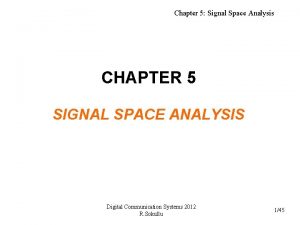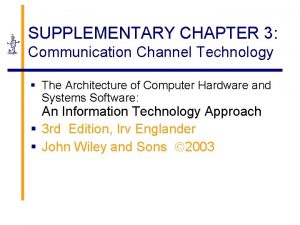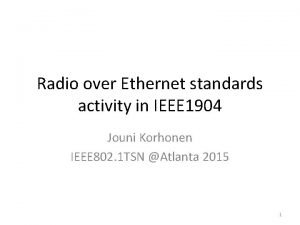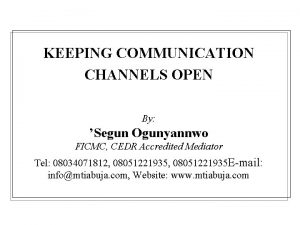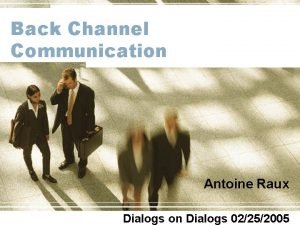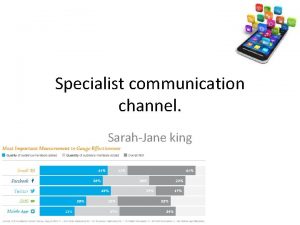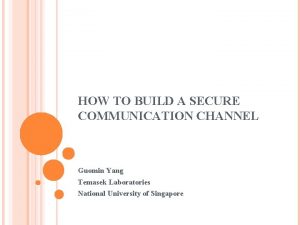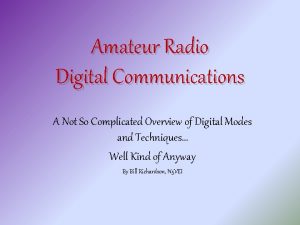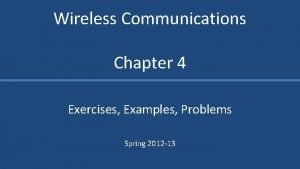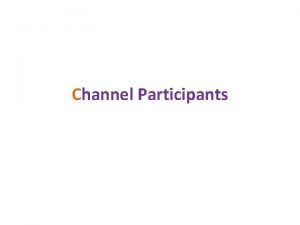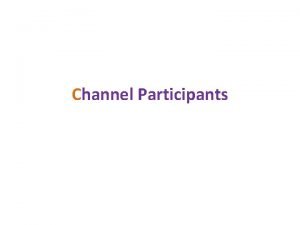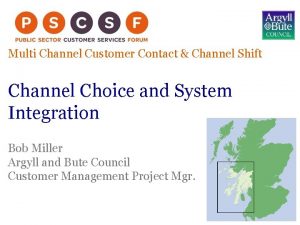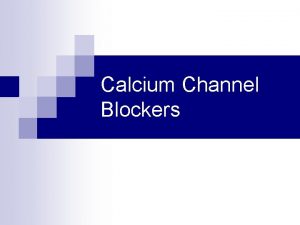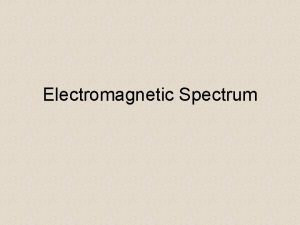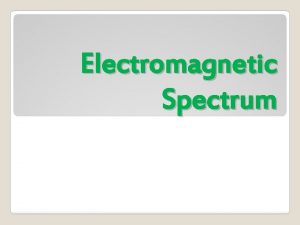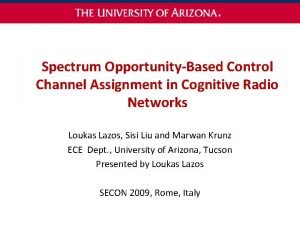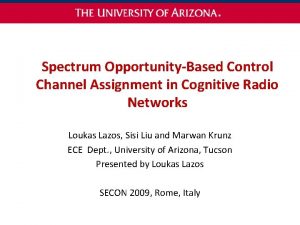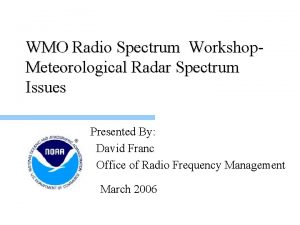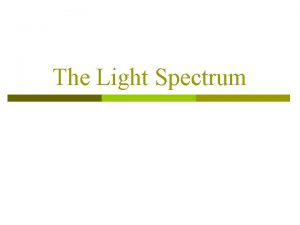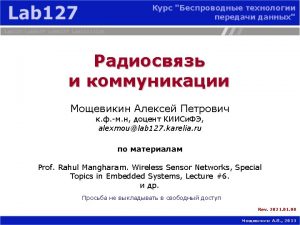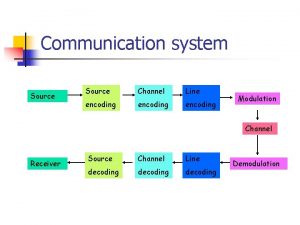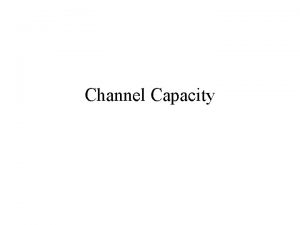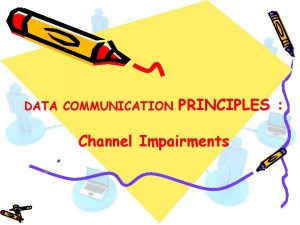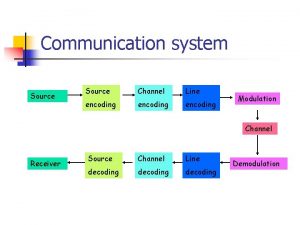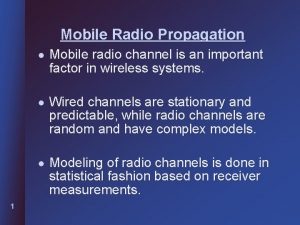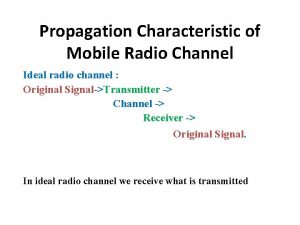Digital Communication over Radio Channel Radio spectrum is































- Slides: 31


Digital Communication over Radio Channel • Radio spectrum is shared in wireless network. • Nodes share a radio spectrum of bandwidth W. • Radio spectrum is centered at carrier frequency, fc. • It is assumed that fc >> W. w 0 ~ - fc ~ w fc 2

Simple Binary Modulation/Detection • Digital communication is achieved over the given radio spectrum by modulating a sequence of pulses by the given bit pattern. • Simple modulator: • If bit is 1: each pulse in pulse train is multiplied by • If bit is 0: each pulse in pulse train is multiplied by . . • The energy of the modulated pulse becomes Es. 3

Additive White Gaussian Noise • As the modulated signal passes through the channel, it is Gaussian white corrupted by noise. signal A "white noise" image • This is taken to be zero mean Additive White Gaussian Noise (AWGN), which means that noise just adds to the signal and is a Gaussian random process with a power spectrum that is constant over the passband of the channel. • The symbol-by-symbol channel model is: Yk = Ck + Zk AWGN Ck Channel f + Yk Read more about Pink, Red (Brownian) and Grey Noise! source symbol sequence Zk output sequence a sequence of i. d. d. zero mean Gaussian random variables with variance N 0/2 4

Probability Density of Statistic Yk • YK can be depicted under the two possible values of Ck that both of them are Gaussian with variance N 0/2. • The detector concludes that the bit sent was “ 0” if the value of Yk is smaller than the threshold, and “ 1” if the value of Yk is more than the threshold. • An error occurs if “ 1” is sent and Yk falls below the threshold, and vice versa. 5

Probability of Error and BER • The probability of error if a “ 0” was sent is equal to the probability of error if a “ 1” was sent and is given by: where. • Hence the probability of error of the binary modulation scheme is: • Note that in this simple modulation, since each symbol is used to send one bit, the error rate obtained is also the Bit Error Rate (BER). 6

Getting Higher Bit Rates • In the simple binary modulation we have already discussed, each pulse is modulated by one of two possible symbols, and the symbol rate is 1/T. • Hence the bit rate is 1/T bps. • There are two possibilities for increasing the bit rate: • Increase the symbol rate; that is, decrease T. • Increase the number of possible symbols, from 2 to M > 2. 7

Increasing Symbol Rate • If the pulse bandwidth is limited to W/2, half of channel bandwidth, then the pulse duration will not be time limited. • Thus the received signal in a symbol interval will be the sum of the pulse in that interval and parts of pulses in neighboring intervals. • The pulses therefore have to be appropriately designed to take care of this effect. • This leads to the so-called Nyquist criterion, which Read more: the to no more than Is itlimits possible to pulse samplerate without considering the. W: Nyquist criterion? YES! Read about Compressive Sensing (CS) and Sparse Signals. 8

Increasing Number of Symbols (1) • (a) shows simple binary symbol set that is called Pulse Amplitude Modulation (PAM). • (b) shows the simplest possibility of increasing number of symbol which is called 4 -PAM. • In 4 -PAM, when transmitting the left-most and rightmost symbols, the symbol energy is 32 times larger than that for two other symbols. Flat-top PAM (Pulse Amplitude Modulation) 9

Increasing Number of Symbols (2) • Another alternative is to have two-dimensional symbols. • (a) shows symbol set where all symbols have the same amplitude but different phases. This is called Quadrature Phase Shift Keying (QPSK). • In fact, QPSK is the superposition of two orthogonal PAM signals. • (b) shows received symbols after corruption by noise. By utilizing both dimensions, for a given probability of error, a smaller symbol spacing can be used than of 4 -PAM, Hence given BER can be achieved with less average power. 10

Channel Coding (1) • Due to physical limitations, it is not always possible to increase SNR so as to reach certain BER. • Some applications might need a lower BER to achieve reasonable performance. • For packet length of L bits and BER of ɛ, the Packet Error Rate is 1 -(1 -ɛ)L. • Required BER can be reduced by channel coding. 11

Channel Coding (2) • In channel coding, blocks of the incoming bits of length K are coded into code-words of length N (>K), thus introducing redundancy. • Since the number of possible code strings (2 N) is larger than the number of possible source strings (2 K), the code-words can be chosen so that there is sufficient spacing between them. • Hence, by using nearest code-word decoding, even if the channel causes errors, the original source string can be inferred with a small residual error probability. 12

Channel Coding (3) • Error performance is improved by increasing N, but this reduces the information rate. • Shannon’s noisy channel coding theorem states that there is a number C, called the channel capacity, such that if R < C, then, as the block length increases, an arbitrarily small BER can be achieved (of course, at the cost of a large block coding delay). • If we attempt to use R > C, then the BER can’t be reduced to zero. • In two-level modulation, for bit error rates of 10 -3, the Es/N 0 values required were approximately 7 d. B. • With a high quality rate ½ code, the required Es/N 0 can be reduced by 2 d. B. • This reduction in Es/N 0 is called coding gain. 13

Inter-symbol Interference (1) Delay Spread causes Inter-Symbol • Several signals may be Interference detected by receiver from different paths. • The difference between the smallest signal delay and the largest signal delay is called the delay spread (Td). • When the delay spread is not very small compared to the symbol time then the superposition of the signals received over the variously delayed paths at the receiver results in Inter-Symbol Interference (ISI). • But if the symbol time is sufficiently bigger than delay imposed by different paths, the symbols are still separately discernible, except that each is multiplied by a complex “attenuation”. 14

Inter-symbol Interference (2) • We can write the k-th received symbol after down conversion as: Yk = G k X k + I k + Z k where Xk is the k-th symbol, Gk is the random attenuation of the k-th symbol, Ik is a complex random variable that models the interference, and Zk is a sequence of complex random variables that models the additive noise. • In this case, BER becomes a function of the Signal to Interference plus Noise Ratio (SINR). 15

Inter-symbol Interference (3) • A channel may have memory, which extends over Jd symbols: Gk( j), 0 ≤ j ≤ Jd − 1, are complex random variables that model channel attenuation and phase shift of the transmitted symbols for every k. • Gk( j) models the influence that the input j symbols in the past has on the channel output at k. • The channel gain at the k-th symbol could be a function of the symbol index k showing that fading is a time-varying phenomenon. 16

Inter-symbol Interference (4) Example: Equalization of FSK • We can combat ISI by passing the received signal Magnitude frequency through a channel equalizer which compensate for the response of channel delays, making the overall system (a combvarious filter, typicalchannel of multipath channels)like a fixed delay channel. appear The equalizer response • Channel equalizer needs to be adaptive in a mobile (ideally, this should be wireless situation, owing to mobility and changing the exact inverse of the channel)path between transmitter and receiver. The combined response (close to 0 d. B at the low frequencies) 17

Fading (1) • The delay spread (Td) is a time domain concept. It can also be viewed in the frequency domain. • Carrying symbols Xk over the RF spectrum: • multiplying them with a (baseband) pulse of bandwidth approximately W/2 (e. g. , 100 KHz) • and up-converting the resulting signal to the carrier frequency (e. g. , 900 MHz). • Some of the frequency components in the pulses can get selectively attenuated, resulting in the corruption of the symbols they carry. • This is called frequency selective fading. 18

Fading (2) • If Td << 1/W , then the pulse would be passed through with only an overall attenuation that called flat fading. • The reciprocal of the delay spread is called the coherence bandwidth (Wc). • If Wc >> W then all the frequencies fade together and we have flat fading. • The assumption of flat fading is reasonable for a narrowband system. • The available radio spectrum is channelized, each bit stream occupies one channel so symbol duration becomes larger than the delay spread. 19

Channel Capacity • Capacity of AWGN channel (without fading) is: C = B log 2(1+S/N) bps or C = log 2(1+S/N) bps/Hz • If average power is Pav and Power Spectral Density (PSD) of Noise is N 0 (W/Hz) then: C = B log 2(1+Pav/N 0 B) bps 20

Diversity (1) • If the receiver has multiple antennas, and if the Space Diversity antennas are spaced sufficiently far apart (at least half of the carrier wavelength), then for the same transmitted signal, the signals received at the different antennas fade approximately independently. • If the paths can be resolved, by combining the received signals over multiple paths, the bit error probability performance can be improved. • So, we have diversity gain. SIMO (Receive) MISO (Transmit) MIMO • Such a receiver is said to exploit multipath diversity. 22

Diversity (2) • The channel fade process, Gk, is correlated over periods called the channel coherence time, which depends on the speed of movement of the mobile device. • Interleaving is a way to obtain an uncorrelated fade process from a correlated one. • We say that interleaving exploits time diversity. • Interleaving fails if the fading is very slow. 23

Diversity (3) • Parallel channels between a transmitter-receiver pair can arise, if the system bandwidth is partitioned into several orthogonal channels. • The multiple transmit antenna system and multiple receive antenna system (also called a Multiple-Input-Multiple. Output (MIMO) system) is equivalent to several parallel channels. • For an M×M MIMO system the capacity scales as: . • This is called multiplexing gain. 24

Diversity (4) • In Summary, multiple antenna system might used to: • Obtain diversity gain • Increase channel capacity • For an N transmit antenna, and M receive antenna system, the diversity gain is bounded by M × N, whereas the multiplexing gain is limited to min{M, N}. • We assumed that the channel gains are unknown at the transmitter. • If channel gain estimates could be provided to the transmitter, then it could judiciously choose the transmitted symbols and their powers, so that the better of the parallel spatial channels are assigned the larger transmit powers. 25

Wideband systems FDMA vs. OFDM • Unlike the narrow-band digital modulation used in FDM OFDMA -TDMA (Frequnecy Division Multiplexing – Time Division Multiple Access) systems, in CDMA (Code Division Multiple Access) and OFDMA (Orthogonal FDMA Frequency Division Multiple Access) the available spectrum is not partitioned, but all of it is dynamically shared among all the users. • The simplest viewpoint TDMA is to think of CDMA in the time domain and OFDMA in the frequency domain. OFDM • In a wideband system, user’s symbol rate is much smaller than the symbol rate that the channel can carry. 26

CDMA (1) • In CDMA a user’s symbol, which is of duration L channel symbols (also called chips), is multiplied by a spreading code of length L chips. • Because of multiplication by the high rate spreading code, the signal spectrum being spread out to cover the system bandwidth, which is called Direct Sequence Spread Spectrum (DSSS). • Spreading factor is L= Rc/R (>1), where R is user’s bit rate and Rc is chip rate (>R) • Spreading codes take values in the set {-1, +1}L • Each code is approximately orthogonal to all the time shifts of the other codes, and also to its own time shifts. 27

CDMA (2) 28

CDMA (3) • If the receiver can lock into any of paths, then the transmitted symbol can be decoded • If the paths fade independently, then we can exploit multipath diversity. • The orthogonality property at the receiver, the multiplication of the received signal by various shifts of the spreading code, and appropriate linear combination of the results, yields a detection statistic that is the sum of several faded copies of the user symbol. • Since these shifts correspond to different paths from the transmitter to the receiver, this is called multipath resolution. • In the context of CDMA systems this is achieved by the Rake receiver. • Rake receiver permits a desired BER to be achieved with a smaller SINR. 29

OFDMA (1) • OFDMA is based on OFDM (Orthogonal Frequency Division Multiplexing), which cab be viewed as statically partitioning the available spectrum into several subchannels, each of bandwidth B << 1/Td. Thus a flat fading model can be used for each subchannel. • The term orthogonal in OFDM refers to the fact that the center frequencies of the subchannels are separated by the reciprocal of the OFDM block time, T. 30

OFDMA (2) • In OFDMA, the system bandwidth, W, is partitioned into overlapping subchannels, each of bandwidth B, with their center frequencies spaced apart by 1/T, where T is the OFDMA symbol duration. 31

OFDMA (3) • It can be shown that fading is uncorrelated between subcarriers that are spaced apart by more than the coherence bandwidth, Wc, which related roughly reciprocally to the delay spread, Td. • As time diversity is exploited in TDM systems, frequency diversity can be exploited in OFDM systems. • Depending on the rate requirement of each user, a certain number of sub-channels can be dynamically allocated to each of the users. • We note that, unlike static allocation on FDM-TDMA systems, the resource allocation decisions in OFDMA can vary from frame to frame, depending on channel conditions and traffic demands 32
 Chromium and copper electron configuration
Chromium and copper electron configuration Absorption spectrum
Absorption spectrum Spectrum mi plan latino silver
Spectrum mi plan latino silver Single channel vs multi channel retailing
Single channel vs multi channel retailing Signal space analysis in digital communication
Signal space analysis in digital communication Jfet self bias configuration
Jfet self bias configuration What is electromagnetic spectrum
What is electromagnetic spectrum Over the mountain over the plains
Over the mountain over the plains Siach reciting the word over and over
Siach reciting the word over and over Explain how to handing over and taking over the watch
Explain how to handing over and taking over the watch Supplementary means of communication
Supplementary means of communication _is the very important function in the radio telex system
_is the very important function in the radio telex system Radio over ethernet
Radio over ethernet Awin support
Awin support Keep the communication channel open
Keep the communication channel open Back channel communication
Back channel communication Specialist communication channel
Specialist communication channel Secure communication channel
Secure communication channel Communication channel threats
Communication channel threats Satellite digital audio radio service
Satellite digital audio radio service Amateur radio digital communications
Amateur radio digital communications Prension cubito palmar
Prension cubito palmar Prension radio digital
Prension radio digital Warga digital adalah
Warga digital adalah Unique features of digital markets
Unique features of digital markets Digital data digital signals
Digital data digital signals Data encoding and modulation
Data encoding and modulation E-commerce: digital markets, digital goods
E-commerce: digital markets, digital goods Digital data to digital signal encoding
Digital data to digital signal encoding Luxembourg digital innovation hub
Luxembourg digital innovation hub Unique features of digital markets
Unique features of digital markets Radio communication exercises
Radio communication exercises




